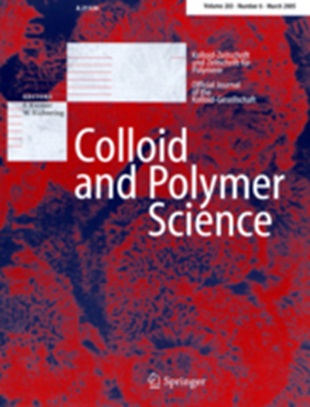利用Pluronic F98胶束的物理化学和光物理研究进行宇宙性盐析验证
摘要
亲宇宙盐降低了三嵌段共聚物(bcp)的浊点(CP),并在较低浓度和温度下表现出胶束化。我们的研究利用了各种物理化学技术,包括张力法、量热法、粘度法、光谱学和散射法,来了解自组装现象。此外,采用光物理方法,以香豆素151 (C-151)染料为探针,报道了高亲水性F98在水和NaCl溶液中随温度的自组装机理。NaCl的加入使CP值降低% w/v F98, inducing a significant influence on the micellization behavior. Such an effect is attributed to the dehydration of the PEO blocks of F98. The surface tension (γ) measurements provided an insight into the intermolecular hydrophobic interactions at the air–water interface, indicating the enhanced surface activity in the presence of NaCl as a function of temperature. As the temperature or NaCl concentration increases, the solution flow behavior in terms of relative viscosity \(\left({\eta }_{rel}\right)\) notably rises due to the enhanced intermicellar interactions with the continued dehydration of the PEO shell of F98. The salting-out effect of the PEO and PPO blocks of F98 in the presence of NaCl was evaluated by observing changes in bond stretching through Fourier-transform infrared (FT-IR) spectroscopy. Two-dimensional nuclear Overhauser effect spectroscopy (2D-NOESY) revealed insights into the spatial arrangement and dynamic interactions of NaCl binding with the PEO corona (~ 3.0–4.0 ppm) of F98. This binding reduced hydration and significantly altered the micellar dynamics. Additionally, minor shifts observed in the PPO signals (~ 1.0–1.5 ppm) suggested indirect interactions, pointing to changes in the internal environment and segmental dynamics of the micellar core. The spectral behavior is further validated by evaluating optimum descriptors using computational simulations performed with the DFT/B3LYP method within the 3-21G basis set framework, utilizing the Gaussian 5.0.9 software. The absorption spectra under increased NaCl concentration and higher temperatures render the microenvironment around the probe C-151 more hydrophobic, suggesting the formation of H-type aggregation. Additionally, fluorescence excitation spectra indicated a blue shift with increasing NaCl concentration, further supporting H-type aggregation. Here, the average fluorescence lifetime remained constant at ~ 5.4 to ~ 5.7 ns, as observed from fluorescence emission decays. Such consistency in fluorescence lifetime, despite forming H-type and J-type aggregations, indicates that the structural changes around the probe do not significantly affect its excited-state dynamics. It has been observed that the addition of NaCl influences the spectral behavior of F98 due to the dehydration of thermosensitive regions as a function of temperature, likely due to the salting-out effect. Dynamic light scattering (DLS) analysis exhibited temperature-dependent variations in F98 micelle size in the presence of NaCl at varying concentrations, attributed to the screening and salting-out effects, which was further validated from small-angle neutron scattering (SANS) investigation, utilizing a core–shell spherical model. Furthermore, our investigation included a spectral analysis that depicted an improved solubilization assessment of the hydrophobic dye Orange OT expressed in dye loading efficiency (DL%) and encapsulation efficiency (EE%), thereby inferring NaCl to dehydrate the copolymeric micelles due to the salting-out effect.Graphical abstractScattering and photophysical profile of 10% w/v F98 in water (blank) and with 2 M NaCl at 30 °C.Kosmotropic salts lower the cloud point (CP) in triblock copolymers (BCPs) and exhibit micellization at lower concentrations and temperatures. Our investigation utilizes various physiochemical techniques, including tensiometry, calorimetry, viscosity, spectroscopy, and scattering, to understand the self-assembly phenomenon. Furthermore, by employing photophysical methods, using Coumarin 151 (C-151) dye as a probe, the self-assembly mechanism in the highly hydrophilic F98 in water and NaCl solutions with temperature is reported. Adding NaCl decreases the CP of 10% w/v F98, inducing a significant influence on the micellization behavior. Such an effect is attributed to the dehydration of the PEO blocks of F98. The surface tension (γ) measurements provided an insight into the intermolecular hydrophobic interactions at the air–water interface, indicating the enhanced surface activity in the presence of NaCl as a function of temperature. As the temperature or NaCl concentration increases, the solution flow behavior in terms of relative viscosity \(\left({\eta }_{rel}\right)\) notably rises due to the enhanced intermicellar interactions with the continued dehydration of the PEO shell of F98. The salting-out effect of the PEO and PPO blocks of F98 in the presence of NaCl was evaluated by observing changes in bond stretching through Fourier-transform infrared (FT-IR) spectroscopy. Two-dimensional nuclear Overhauser effect spectroscopy (2D-NOESY) revealed insights into the spatial arrangement and dynamic interactions of NaCl binding with the PEO corona (~ 3.0–4.0 ppm) of F98. This binding reduced hydration and significantly altered the micellar dynamics. Additionally, minor shifts observed in the PPO signals (~ 1.0–1.5 ppm) suggested indirect interactions, pointing to changes in the internal environment and segmental dynamics of the micellar core. The spectral behavior is further validated by evaluating optimum descriptors using computational simulations performed with the DFT/B3LYP method within the 3-21G basis set framework, utilizing the Gaussian 5.0.9 software. The absorption spectra under increased NaCl concentration and higher temperatures render the microenvironment around the probe C-151 more hydrophobic, suggesting the formation of H-type aggregation. Additionally, fluorescence excitation spectra indicated a blue shift with increasing NaCl concentration, further supporting H-type aggregation. Here, the average fluorescence lifetime remained constant at ~ 5.4 to ~ 5.7 ns, as observed from fluorescence emission decays. Such consistency in fluorescence lifetime, despite forming H-type and J-type aggregations, indicates that the structural changes around the probe do not significantly affect its excited-state dynamics. It has been observed that the addition of NaCl influences the spectral behavior of F98 due to the dehydration of thermosensitive regions as a function of temperature, likely due to the salting-out effect. Dynamic light scattering (DLS) analysis exhibited temperature-dependent variations in F98 micelle size in the presence of NaCl at varying concentrations, attributed to the screening and salting-out effects, which was further validated from small-angle neutron scattering (SANS) investigation, utilizing a core–shell spherical model. Furthermore, our investigation included a spectral analysis that depicted an improved solubilization assessment of the hydrophobic dye Orange OT expressed in dye loading efficiency (DL%) and encapsulation efficiency (EE%), thereby inferring NaCl to dehydrate the copolymeric micelles due to the salting-out effect.
Graphical abstract
Scattering and photophysical profile of 10% w/v F98 in water (blank) and with 2 M NaCl at 30 °C.

 求助内容:
求助内容: 应助结果提醒方式:
应助结果提醒方式:


